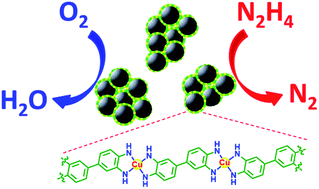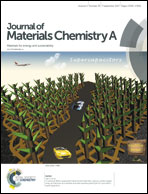Driving electrochemical oxygen reduction and hydrazine oxidation reaction by enzyme-inspired polymeric Cu(3,3′-diaminobenzidine) catalyst†
Abstract
Owing to the well-defined molecular structure and tunable mono-, di- or multinuclearity, Cu–N complexes have recently drawn specific attention as emerging catalysts for sustainable electrocatalytic oxygen reduction reaction (ORR) and other reactions. However, compared to state-of-the-art Pt/C, most of these Cu-based molecular catalysts show low catalytic activity due to the intrinsically limited capability and challenges in electronic structure modulation and sequential electron transfer within a single small molecule. Herein, inspired by structure–property relationships of laccases (a type of macromolecular biological catalyst), we report a facile molecular assembly of Cu(3,3′-diaminobenzidine) polymeric complex on carbon black via Cu–N complexing and π–π interaction as a highly efficient bifunctional electrocatalyst for ORR and hydrazine oxidation reaction (HOR), two half reactions for hydrazine fuel cells. Similar to the function of the Cys–His group in natural laccases, the 3,3′-diaminobenzidine ligand in the proposed polymeric catalyst synergistically adjusted the electronic structure of the Cu–N complex center and mediated a multiple-electron transfer cooperatively with carbon black via a long-range π–π interaction, owing to its electron reservation and π-conjugated properties. This study may provide a new way to design highly efficient biomimetic noble-metal-free electrocatalysts with well-defined and tunable structures.



 Please wait while we load your content...
Please wait while we load your content...